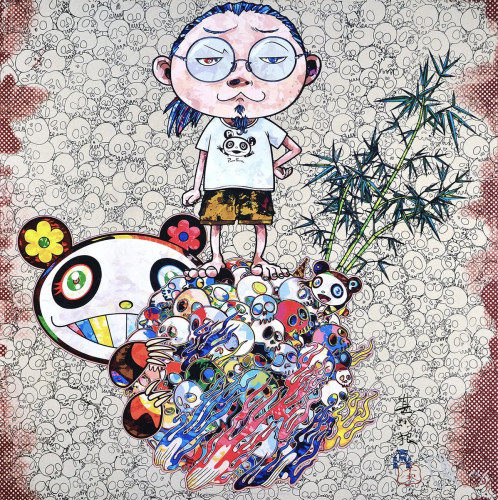Superflat: A Modern Mirror to Traditional Japanese Art

By Elena Fontaine, France
The Superflat art movement, pioneered by Takashi Murakami, is a contemporary art movement steeped in the rich artistic traditions of Japan, yet thoroughly modern in its critique and expression. It emerges from a blend of traditional Japanese artistic aesthetics and the modern-day cultural narratives prevalent in post-war Japan. Superflat goes beyond a mere art style; it's a cultural commentary articulated through the vivid and often whimsical imagery characteristic of the movement.
The essence of Superflat is encapsulated in its name – it’s a flattening of the art, reducing everything to a two-dimensional plane. This is not just a visual flattening, but also a conceptual one, where the distinctions between high art and low culture are obliterated, providing a level playing field for critique and expression.
Takashi Murakami's works, some of which are showcased at Composition Gallery, are exemplary of the Superflat movement. His piece "Flower Ball (3D) - Turn Red!" is a striking illustration of this movement's ethos. The artwork, with its vibrant colors and repetitive, smiling flower motifs, challenges the conventional artistic norms by reveling in its two-dimensional form, while also inviting interpretations relating to contemporary society’s uniformity and superficiality.
Superflat also serves as a bridge between the historical art forms of Japan and the modern-day consumer culture heavily influenced by manga and anime. This is evident in another of Murakami's works, "Korin: Chrysanthemum." Here, he invokes the traditional Japanese Rimpa School, juxtaposed against modern motifs, creating a dialog between Japan’s rich artistic heritage and its contemporary cultural landscape.
The Superflat movement, through its unique visual language, invites viewers to delve into a multifaceted exploration of cultural identity amidst the globalizing forces of the modern world. It’s a movement that resonates beyond the borders of Japan, offering a lens through which to examine the impact of globalization on cultural and artistic expressions.
Murakami’s artworks at Composition Gallery provide a tangible journey into the Superflat realm, each piece inviting the viewer into a narrative that transcends the visual flatness, delving into the intricate interplay between tradition and modernity. The Superflat movement, as mirrored in Murakami’s art, remains a profound exploration of contemporary society, its cultural nuances, and its artistic expressions.
By Elena Fontaine, France
The Superflat art movement, pioneered by Takashi Murakami, is a contemporary art movement steeped in the rich artistic traditions of Japan, yet thoroughly modern in its critique and expression. It emerges from a blend of traditional Japanese artistic aesthetics and the modern-day cultural narratives prevalent in post-war Japan. Superflat goes beyond a mere art style; it's a cultural commentary articulated through the vivid and often whimsical imagery characteristic of the movement.
The essence of Superflat is encapsulated in its name – it’s a flattening of the art, reducing everything to a two-dimensional plane. This is not just a visual flattening, but also a conceptual one, where the distinctions between high art and low culture are obliterated, providing a level playing field for critique and expression.
Takashi Murakami's works, some of which are showcased at Composition Gallery, are exemplary of the Superflat movement. His piece "Flower Ball (3D) - Turn Red!" is a striking illustration of this movement's ethos. The artwork, with its vibrant colors and repetitive, smiling flower motifs, challenges the conventional artistic norms by reveling in its two-dimensional form, while also inviting interpretations relating to contemporary society’s uniformity and superficiality.
Superflat also serves as a bridge between the historical art forms of Japan and the modern-day consumer culture heavily influenced by manga and anime. This is evident in another of Murakami's works, "Korin: Chrysanthemum." Here, he invokes the traditional Japanese Rimpa School, juxtaposed against modern motifs, creating a dialog between Japan’s rich artistic heritage and its contemporary cultural landscape.
The Superflat movement, through its unique visual language, invites viewers to delve into a multifaceted exploration of cultural identity amidst the globalizing forces of the modern world. It’s a movement that resonates beyond the borders of Japan, offering a lens through which to examine the impact of globalization on cultural and artistic expressions.
Murakami’s artworks at Composition Gallery provide a tangible journey into the Superflat realm, each piece inviting the viewer into a narrative that transcends the visual flatness, delving into the intricate interplay between tradition and modernity. The Superflat movement, as mirrored in Murakami’s art, remains a profound exploration of contemporary society, its cultural nuances, and its artistic expressions.















